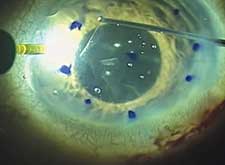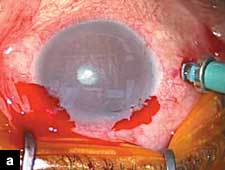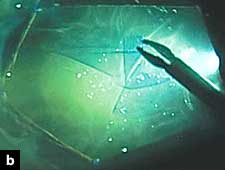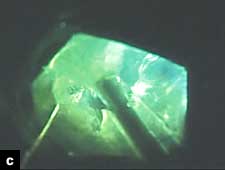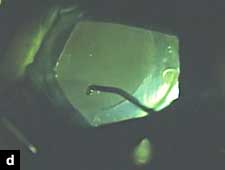Retroillumination looks through corneal opacities
Technique gives greater visual clarity of the lens in phacoemulsification when dealing with a severe hazy cornea.
 Yusuke Oshima |
A recently developed technique has proved successful in overcoming visibility problems in performing cataract surgeries in patients with severe hazy corneas, according to a study conducted at Osaka University Medical School and led by Yusuke Oshima, MD, PhD.
Chandelier illumination, also known as retroillumination, is a technique using a 25- or 27-gauge illumination fiber that is inserted into the vitreous cavity transconjunctivally through the pars plana. It increases the surgeon’s visibility, making phacoemulsification much easier to perform, according to Dr. Oshima.
Beyond improved visibility, the system is also self-retaining, allowing the surgeon to employ the standard bimanual intraocular manipulation typically used in cataract procedures. Previously, surgeons would control some type of light pipe with one hand while working with the other – a departure from the normal technique, he said.
Retroillumination is used in cataract surgeries or cataract surgery combined with Descemet’s stripping automated endothelial keratoplasty (DSAEK), whereas a slightly different technique, known as anterior illumination, can be used for DSAEK only. This particular technique involves chandelier fiber insertion through the corneal limbus, with the tip of the fiber being inserted 3 mm inside the anterior chamber. This illumination technique for DSAEK has had similar success, Dr. Oshima said.
“We have used this technique for cataract surgery and DSAEK combined surgery in over 30 cases. At present, we have not experienced any complications attributable to using chandelier illumination,” he said in an e-mail interview with Ocular Surgery News.
|
Images: Oshima Y |
Surgical procedure
A xenon or mercury light source is added to a 25- or 27-gauge illumination fiber, providing the surgeon with a much clearer view of the nucleus and subsequent lens particles while phacoemulsification is performed.
“The optical fiber outside of the eyeball is covered by an opaque, malleable sleeve to maintain the optimal position of the chandelier within the eye,” Dr. Oshima said. He added that irrigation and aspiration to remove the residual cortex are also performed under chandelier illumination, along with IOL insertion.
Once the IOL has been inserted, the surgeon removes the tip of the chandelier fiber from the pars plana and the wound self-seals without any need for sutures. This was one of the major concerns of the study researchers, Dr. Oshima said.
“[A] concern regarding the chandelier fiber may be the thermal burn-induced tissue damages. The tip of the fiber is covered with a polyamide sleeve that serves both as an insulator to prevent thermal burn-induced sclera or corneal damage and as an optical shield to minimize glare,” he said.
Advantages
Dr. Oshima said he believes that the illumination technique is important for three reasons. First, it allows surgeons to have improved intraocular visibility while performing phacoemulsification. Second, the surgeon is able to perform cataract surgery and DSAEK bimanually, which improves accuracy and increases manual familiarity. And third, the added benefit of the chandelier fiber not causing any tissue damage helps in postoperative healing.
According to Dr. Oshima, he hopes that by understanding and evaluating the benefits of using the chandelier illumination system, ophthalmologists will begin to take a closer look at the technique when performing cataract surgery on patients with severe hazy corneas.
“We believe this technique can expand the surgical indications of cataract surgery and/or DSAEK to cases with severe corneal opacity that have been considered as contraindication for surgical treatment,” he said.
| Retroillumination-assisted phacoemulsification | |
|
|
|
|
|
|
For more information:
- Yusuke Oshima, MD, PhD, can be reached at the Department of Ophthalmology, Osaka University Medical School, Room E7, 2-2 Yamadaoka, Suita, Osaka 565-0871, Japan; +81-6-6879-3456; fax: +81-6-6879-3458; e-mail: oshima@ophthal.med.osaka-u.ac.jp.
Reference:
- Oshima Y, Shima C, Maeda N, Tano Y. Chandelier retroillumination-assisted torsional oscillation for cataract surgery in patients with severe corneal opacity. J Cataract Refract Surg. 2007;33:2018-22.
- Andrew Kelly is an OSN Staff Writer who covers all aspects of ophthalmology. He focuses geographically on the Europe and Asia-Pacific region.

